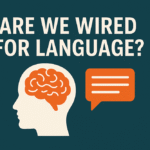One of the things I enjoy most about my doctoral studies is how many different subjects I get to explore. My work crosses over into several areas, including:
- Mathematics
- Linguistics
- Information theory
- Bioinformatics and genetic sequencing
- History and prehistory
- Complex systems theory
And many more.
Studying such a wide range of topics gives me new ways of thinking about familiar problems. It also sends me down a lot of fascinating rabbit holes. One area I keep coming back to is biological evolution and the origin of life.
Although the origin of life and evolution are two separate topics, they are closely connected. In this post, I’m setting aside the origin of life(to an extent) and focusing on how evolution connects to the fields I study.
1. Evolution as a Complex System
One area I study is complex systems. These are systems made up of many parts that interact in ways that are hard to predict by just looking at the parts on their own.
A great example of this is a flock of birds flying in a big group. Each bird is just following a few simple rules: stick close to nearby birds, don’t crash into them, and fly in the same general direction. That’s it.
But when all the birds follow these rules together, something amazing happens. The flock moves as one giant shape, twisting and turning through the air, reacting instantly to things like predators or changes in the wind. No one bird is in charge, yet the group moves in a beautifully organized way.
That’s what we call a complex system. The whole group behaves in a way that no single bird could plan.
Evolution works in a similar way. Genes, environments, and organisms all interact. These interactions create patterns and changes across time. The system is complex, and the results are often surprising. We see this in the way ecosystems form, how species adapt, and how life becomes more diverse.
2. Language and Evolution Work in Similar Ways
Language is also a complex system. Like birds in a flock, speakers of a language follow simple rules. We use grammar, pronounce words in a certain way, and choose vocabulary based on what we’ve learned from others.
As people talk to each other, small changes in how we speak slowly spread. New words are created, old ones fade, and grammar rules shift. Over time, entire languages change and evolve, even though no one is trying to plan it.
In both language and biology, the system is shaped by local interactions, variation, and time. Small changes can build up into major shifts.
3. Language and Genes Can Be Modeled in Similar Ways
It turns out that we can use some of the same tools to study both language and genetic systems. That’s because both involve information built from smaller units that follow rules about how they can combine.
For example:
- Markov chains can predict what comes next in a sequence. These are used in both genetic research and in things like autocomplete or spell check.
- Information theory helps us measure how much information is in a sentence or a DNA sequence. We can ask how predictable or surprising each part is.
- Combinatorics lets us count how many possible combinations can be made from a set of elements. This is useful in both genetics and linguistics.
- Phylogenetic trees help us trace how languages or species have changed and split over time. We use similar methods to map both.
- Big data tools let us analyze huge collections of text or genetic sequences to find patterns and trends.
This shows that understanding evolution doesn’t only depend on biology. In fact, you could argue that other fields, like math, computer science, and systems theory, are just as important if not more.
And this leads to some big, thought-provoking questions about the theory of evolution and the origin of life.
Where Did the Information in DNA Come From?
DNA is the molecule that stores instructions for life. But we face a puzzle: to have a working cell, you need DNA. But to make DNA, you need a working cell. Which came first? Information in the cell is seemingly present since the beginning of time. How did it get there?
So far, scientists haven’t found a clear, proven explanation for how meaningful, useful information like DNA could arise from pure randomness. In all our experiments, we’ve never seen complex information just appear without some kind of guiding structure, process or intelligence. This remains one of the deepest questions in science.
Random Mutation Often Creates More Junk Than Progress
In both DNA and language, random changes usually don’t lead to anything useful.
The number of possible combinations in a DNA sequence grows incredibly fast as the sequence gets longer. Almost all of those combinations do nothing. Some are harmful. A few are neutral. Very few actually do something helpful.
This is what David Berlinski called the problem of “combinatorial inflation.” As the number of possible combinations explodes, it becomes extremely unlikely that a random change will produce something meaningful.
The same thing happens in language. If you randomly rearranged letters or words, most of what you’d get would be nonsense. Every now and then, you might accidentally create a clever new phrase, but the odds are low.
There’s a great moment in The Simpsons that captures this. Mr. Burns puts a bunch of chimpanzees in a room with typewriters, hoping they’ll write a novel. One chimp hands him a page that reads, “It was the best of times, it was the blurst of times?!” It’s a funny mistake, but also a clever way of showing that randomness doesn’t easily produce brilliance. Without feedback, structure, or filtering, you mostly get gibberish.
What About the Cambrian Explosion?
The Cambrian Explosion was a time around 541 to 510 million years ago when a huge variety of complex animals suddenly appeared in the fossil record. These creatures had features like eyes, shells, limbs, and segments.
Before this, most life was soft-bodied and microscopic. Then, within a few tens of millions of years, a short time in geological terms, we see a big burst of complexity.
From a strictly observational, scientific point of view, this raises questions. We don’t have complete fossil records for all the animal groups that appeared. Some seem to show up without much evidence of what came before. Transitional fossils like Kimberella and Dickinsonia give us clues, but the picture is still incomplete.
This doesn’t mean evolution didn’t happen. But it does show that our current fossil evidence doesn’t tell the whole story. There are still pieces of the puzzle missing, and we should be honest about that.
One of the great things about studying across different disciplines is that it helps you see patterns that others might miss. It also helps you ask deeper questions.
Evolution is not just about biology. It connects to math, language, systems theory, and information science. The more angles we bring to it, the better we can understand how life changes, how complexity arises, and what kinds of systems can create and sustain information.
These questions are far from settled. But asking them, across fields, from different perspectives, is what keeps the pursuit of knowledge exciting. That’s the rabbit hole I’m glad to be lost in.





